Strategic Collaborations for Durability: Bagley Risk Management
Strategic Collaborations for Durability: Bagley Risk Management
Blog Article
Recognizing Livestock Risk Protection (LRP) Insurance Coverage: A Comprehensive Guide
Browsing the world of animals risk protection (LRP) insurance coverage can be an intricate venture for lots of in the farming market. This sort of insurance policy provides a safety web against market changes and unanticipated scenarios that can influence animals producers. By recognizing the complexities of LRP insurance policy, manufacturers can make enlightened decisions that may secure their operations from economic risks. From exactly how LRP insurance coverage works to the numerous insurance coverage alternatives available, there is much to discover in this thorough overview that could possibly shape the way animals producers approach danger management in their organizations.

How LRP Insurance Coverage Functions
Sometimes, understanding the technicians of Livestock Danger Defense (LRP) insurance coverage can be complex, but damaging down how it works can supply clearness for breeders and farmers. LRP insurance policy is a danger monitoring device designed to safeguard livestock producers against unexpected price decreases. It's vital to note that LRP insurance is not an income assurance; instead, it focuses only on cost danger defense.
Eligibility and Protection Options

When it comes to insurance coverage options, LRP insurance uses manufacturers the versatility to pick the protection level, coverage period, and endorsements that best fit their danger administration demands. By understanding the qualification standards and protection options offered, animals producers can make informed choices to handle threat effectively.
Benefits And Drawbacks of LRP Insurance
When evaluating Animals Danger Protection (LRP) insurance coverage, it is essential for livestock manufacturers to consider the drawbacks and benefits intrinsic in this risk management tool.

One of the main benefits of LRP insurance coverage is its capability to provide security against a decline in livestock rates. Furthermore, LRP insurance supplies a degree of adaptability, enabling manufacturers to personalize coverage degrees and plan periods to suit their certain needs.
One restriction of LRP insurance policy is that it does not shield versus all types of dangers, such as illness break outs or navigate to this site all-natural catastrophes. It is critical for producers to meticulously analyze their private risk direct exposure and financial circumstance to establish if LRP insurance policy is the appropriate threat management device for their operation.
Recognizing LRP Insurance Premiums

Tips for Making Best Use Of LRP Conveniences
Making best use of the benefits of Livestock Threat Protection (LRP) insurance calls for strategic preparation and positive danger management - Bagley Risk Management. To maximize your LRP insurance coverage, think about the following tips:
Frequently Examine Market Conditions: Remain educated concerning market fads and rate fluctuations in the animals sector. By checking these elements, you can make educated decisions regarding when to acquire LRP protection to safeguard against prospective losses.
Set Realistic Protection Levels: When selecting coverage levels, consider your production costs, market price of animals, and prospective dangers - Bagley Risk Management. Establishing sensible coverage levels ensures that you are adequately protected without overpaying for unnecessary insurance
Diversify Your Coverage: As opposed to relying solely on LRP insurance policy, consider expanding your threat administration methods. Integrating LRP with various other risk administration devices such as futures contracts or options can provide extensive coverage against market uncertainties.
Testimonial and Adjust Insurance Coverage Regularly: As market conditions transform, occasionally review your LRP insurance coverage to guarantee it aligns with your present risk direct exposure. Changing protection levels and timing of acquisitions can aid enhance your danger defense technique. By adhering to these ideas, you you can find out more can maximize the advantages of LRP insurance coverage and protect your animals procedure against unforeseen risks.
Conclusion
To conclude, animals danger security (LRP) insurance is a valuable tool for farmers to handle about his the monetary risks associated with their animals procedures. By recognizing just how LRP functions, qualification and protection options, along with the benefits and drawbacks of this insurance, farmers can make informed decisions to protect their livelihoods. By thoroughly thinking about LRP costs and carrying out approaches to take full advantage of benefits, farmers can alleviate prospective losses and make sure the sustainability of their operations.
Livestock manufacturers interested in obtaining Animals Threat Defense (LRP) insurance policy can discover a variety of qualification standards and coverage alternatives customized to their certain animals procedures.When it comes to coverage options, LRP insurance provides producers the versatility to pick the insurance coverage degree, protection duration, and endorsements that finest fit their danger management needs.To understand the complexities of Livestock Threat Protection (LRP) insurance coverage fully, recognizing the aspects affecting LRP insurance premiums is important. LRP insurance policy costs are established by different components, including the coverage level picked, the anticipated price of livestock at the end of the insurance coverage period, the type of livestock being insured, and the size of the coverage duration.Testimonial and Change Coverage On a regular basis: As market conditions change, periodically examine your LRP protection to ensure it lines up with your present threat direct exposure.
Report this page